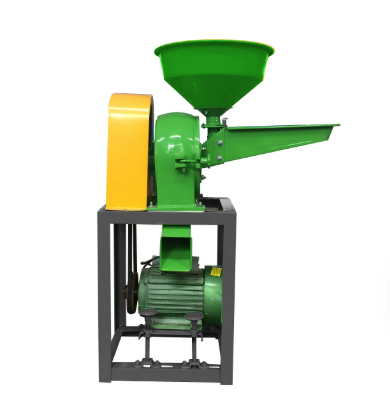Traditional vs. Modern Rice Mills
Stone Grinders and Manual Hullers
Stone grinders also have a history in the world of traditional rice milling. These levelers were primitive for centuries with human power consisting of a lot of them milling rice. This action is done with a stone grinder which crushes the husk and removes the bran (the outer layer) yielding polished rice. Figure 1 Although conventional, such procedure is very time-consuming and also ineffective in some degree, especially in output. Hand operated hullers are also vital to small scale rice growing. They enable farmers to peel off the rice husk by hand and are essential for villagers with no access to modern machinery. However, the traditional methods described above have disadvantages such as low efficiency, high labor requirement, which bringing down production efficiency and might affect quality uniformity of rice.
Innovations in Steel Roller Technology
Rice milling with steel rollers is a major development for rice milling; it obviates the need for the more ancient methods of stone grinding and manual hulling. Steel rollers also run by themselves -- in stark contrast to earlier models which required more manpower -- providing an additional layer of efficiency to husking and whitening work. This equipment has drastically transformed the rice milling process, speeding-up batching operations and minimizing hand-operation while effectively increasing throughput. Introduction of rice mill machinery in rice batch industry is a partial automated mode of operation that is used by many rice industries to make less bourne on manual work. Modern technology, which helps to improve the quality of the rice, reduces more bran and impurities, which results in better quality. Mills that invest in these new processes will en- sure uniform quality and possibly a higher return, as lower milling losses translate to better options to satisfy consum- ers who want better rice.
Core Types of Rice Milling Machines
Single-Pass Rice Mills
Single pass rice mills provide an ideal form of grain treatment for the purpose of milling rice fresh and fresh irrespective of time. These machines are capable of husking and whitening rice in just one process making it suitable for smaller/medium sized firms. They are especially good for people who are looking for new ways to speed up milling without adding any new or expensive equipment. Their success in rice processing could be based on industry data indicating that single-pass mills are playing a major role in achieving efficiency in rice production, with high levels of production. For example, they’re great for small farms seeking to boost their output without investing much in technology.”
Multi-Pass Rice Processing Systems
Multi-staged rice mill system takes an alternative path, which incorporating several milling stages, namely cleaning, husking, whitening, polishing, and sorting. These processes are quality and yield driven aligning more with raw materials efficiency as compared to its single-pass precursor. Such systems are used in countries or industries which specialise in the production of high-value rice in large quantities. Their step by step processing system ensures that the rice has an excellent finish, and are perfect for producers who intend to make decent rice. Large-scale operations, such as those based in areas of high rice consumption (southeast Asia, for example), also commonly use multi-pass systems.
Compact and Mini Milling Solutions
Compact & Mini milling solutions have become the most popular choice for the small and medium-sized farmers, and can easily be processed the cost of the mini milling machines. These machines are the perfect fit for the rice farmers that can't justify an expensive expenditure. The goal of such devices is to minimise the ground space needed, while still providing a good quality milling system. Success stories Farmers who have adopted the solutions share testimonials that paint a picture of better productivity and profitability although they are still on a much smaller scale. Farmers, particularly in developing countries, frequently adopt such small scale systems to improve rice milling without large investments. System like these empower smaller sized setup to compete with big players by making good use of their resources.
Commercial and Industrial Rice Mills
High-Capacity Automated Systems
High-throughput automation has revolutionized industrial rice processing to allow heavy duty operations at the extensive level without much manual work. This kind of systems include smart devices, sensors and software in such a way that the hospitality management becomes more and more efficient. Sensors provide status of grinding for relief and clearance grind as well as detection of unallowable conditions, and software driven phased dressing to support analysis of process data provide a cut and dry solution to grinding improvements. Over the past few years, there has been a noticeable surge in the uptake of these automated tools across market verticals. This increase comes in response to increased consumer demand for high-quality rice. There are small labor saving paddy processing systems available however they are not only increasing the advanced productivity but also improving the quality of the total rice processed.
Specialized Equipment for Quality Control
Quality control in rice mills plays a key role in competition. And different specific machines are used to clean or grade the rice to meet the necessary standards. It also applies to sorting machines, which segregate grains based on size and colour, and grading machines that separates rice by the quality of parameters like length and polish. In addition, product testing equipment guarantees safety and nutritional quality. If a manufacture does not take quality control seriously, then this could result in poor products, damaging the brand and consumer confidence. Therefore, the investment in a dedicated QA system is essential for obtaining and protecting a firm position in the market and guaranteeing that manufactured rice is as expected by the consumer.
Key Considerations When Choosing a Rice Mill
Production Capacity and Efficiency
It’s essential to consider your choosen rice milling line's production capacity, as it is one of the factors that help you gain the edge in the market. Ideally your rice mill should be able to tailor to the milling and processing needs of the local market, ensuring minimal wastage and maximum efficiency. For instance, in rice mills large-capacity automated systems, like the ones that are used in CÈte dâIvoire, are capable to process one ton per hour as a minimum and this represents a substantial aid in broad-scale rice production. By analysing the efficiency of other operation on output per hour and on scaling, these measures are important not only beyond capacity, but within it. Mills with modern technology generate optimum milling results and prevent excessive waste. Industry leaders typically establish guidelines around these metrics, which makes them useful for startups to both benchmark their own success and to drill down into where there’s room for improvement.
Energy Consumption and Maintenance Needs
The high consume of energy in rice processing industry of 375-625 therm/ton made this sector as a sensitive in energy consumption among agro-based industry. When you select a mill that is designed for low energy consumption, you reduce your costs and cultivate a more sustainable way of doing business. Also, the maintenance requirements are an important factor for the long-term survival of a mill. Despite the high cost of maintenance, applying it regularly can guarantee the best performance of the equipment and avoid expensive downtime. In support of that, the industry has turned to sustainability measures which place an emphasis on minimizing energy footprints and promoting responsible use of resources. They both contribute to decrease costs and improve the mills value in the market and align their actions to global sustainabilities guideline.
FAQ
What are the main differences between traditional and modern rice mills?
Traditional rice mills rely heavily on manual labor and simpler machinery like stone grinders and manual hullers, which can be labor-intensive and inefficient. Modern rice mills utilize advanced technologies like steel roller systems and automation to enhance efficiency, production quality, and output.
How does steel roller technology improve rice milling?
Steel roller technology automates the husking and whitening processes, significantly boosting production efficiency by removing more bran and impurities, thus producing a higher-grade product with less manual labor.
What factors should be considered when choosing a rice mill?
Key considerations include production capacity, efficiency, energy consumption, and maintenance needs. Ensuring the mill aligns with market size and sustainability standards is critical for optimizing costs and competitiveness.

